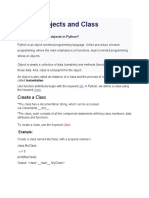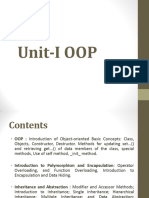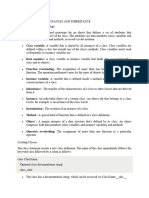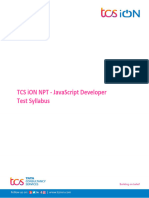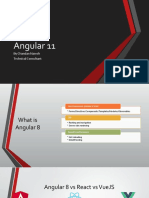Python__OOP Lab 14 (1)
Uploaded by
muhammadmaalikgoogiPython__OOP Lab 14 (1)
Uploaded by
muhammadmaalikgoogiDepartment of Electrical
Engineering
Riphah College of Science & Technology
Faculty of Engineering & Applied Sciences
Riphah International University, Lahore
Program: B.Sc. Electrical engineering Semester: II
Subject: CSL-212 Object Oriented Programming Date: ……………….
Experiment 14: Python Classes and Objects
OBJECTIVES:
(i) To get introduced to the concept of Classes
(ii) To use Objects and Methods of a Class
Name: ….…………………………………………………………
SAP: ……………………………………………………………
No. Lab Evaluation Scheme Obtained
Marks
1 Understanding and Ability to Conduct Experiment. (0-5)
2 Implementation and Results (0-5)
Total
No. Lab Report Scheme Obtained
Marks
1 Report Content (0-5)
2 Code/Output Presentation and Conclusion (0-5)
Total
Remarks (if any): ………………………………….
Name & Signature of faculty: …………………………………
Riphah College of Science and Technology,Lahore
FACULTY OF Electrical Engineering
EEDEPARTMENT
THEORY
Python Classes/Objects
Python is an object oriented programming language. Almost everything in Python is an object,
with its properties and methods. A Class is like an object constructor, or a "blueprint" for
creating objects.
Python Classes
A class is considered a blueprint of objects. We can think of the class as a sketch (prototype)
of a house. It contains all the details about the floors, doors, windows, etc. Based on these
descriptions, we build the house; the house is the object. Since many houses can be made
from the same description, we can create many objects from a class.
Define Python Class
We use the class keyword to create a class in Python. For example,
class Name:
# class definition
Here, we have created a class named Name.
class Bike:
name = ""
gear = 0
Here,
Bike - the name of the class
name/gear - variables inside the class with default values "" and 0 respectively.
Note: The variables inside a class are called attributes.
Object Oriented Programming 2nd Semester-EE RCST Lahore
Riphah College of Science and Technology,Lahore
FACULTY OF Electrical Engineering
EEDEPARTMENT
Python Objects
An object is called an instance of a class. Suppose Bike is a class then we can create objects
like bike1, bike2, etc from the class. Here's the syntax to create an object.
objectName = ClassName()
# create class
class Bike:
name = ""
gear = 0
# create objects of class
bike1 = Bike()
Here, bike1 is the object of the class. Now, we can use this object to access the class attributes.
Access Class Attributes Using Objects
We use the . notation to access the attributes of a class. For example,
# modify the name property
bike1.name = "Mountain Bike"
# access the gear property
bike1.gear
Example 1: Python Class and Objects
# define a class
class Bike:
name = ""
gear = 0
# create object of class
bike1 = Bike()
# access attributes and assign new values
bike1.gear = 11
bike1.name = "Mountain Bike"
print("Name:” ,bike1.name, “Gears”, bike1.gear )
Object Oriented Programming 2nd Semester-EE RCST Lahore
Riphah College of Science and Technology,Lahore
FACULTY OF Electrical Engineering
EEDEPARTMENT
Create Multiple Objects of Python Class
We can also create multiple objects from a single class. For example,
Example
# define a class
class Employee:
# define a property
employee_id = 0
# create two objects of the Employee class
employee1 = Employee()
employee2 = Employee()
# access property using employee1
employee1.employeeID = 1001
print(f"Employee ID: {employee1.employeeID}")
# access properties using employee2
employee2.employeeID = 1002
print(f"Employee ID: {employee2.employeeID}")
Python Methods
We can also define a function inside a Python class. A Python function defined inside a class
is called a method.
Example 2
# create a class # assign values to all the properties
class Room: study_room.length = 42.5
length = 0.0 study_room.breadth = 30.8
breadth = 0.0
# access method of a class
# method to calculate area study_room.calculate_area()
def calculate_area(self):
print("Area of Room =", self.length *
self.breadth)
# create object of Room class
study_room = Room()
Object Oriented Programming 2nd Semester-EE RCST Lahore
Riphah College of Science and Technology,Lahore
FACULTY OF Electrical Engineering
EEDEPARTMENT
In the above example, we have created a class named Room with:
Attributes: length and breadth
Method: calculate_area()
Here, we have created an object named study_room from the Room class. We then used the
object to assign values to attributes: length and breadth. Notice that we have also used the
object to call the method inside the class,
Python Constructors
Earlier we assigned a default value to a class attribute,
class Bike:
name = ""
...
# create object
bike1 = Bike()
However, we can also initialize values using the constructors. For example,
class Bike:
# constructor function
def __init__(self, name = ""):
self.name = name
bike1 = Bike("Mountain Bike")
Here, __init__() is the constructor function that is called whenever a new object of that class is
instantiated. The constructor above initializes the value of the name attribute. We have used
the self.name to refer to the name attribute of the bike1 object. If we use a constructor to
initialize values inside a class, we need to pass the corresponding value during the object
creation of the class.
Note: Here, "Mountain Bike" is passed to the name parameter of __init__().
Object Oriented Programming 2nd Semester-EE RCST Lahore
Riphah College of Science and Technology,Lahore
FACULTY OF Electrical Engineering
EEDEPARTMENT
The self Parameter
The self, parameter is a reference to the current instance of the class, and is used to access
variables that belongs to the class. It does not have to be named self, you can call it whatever
you like, but it has to be the first parameter of any function in the class:
Lab Task
Task 1
Make modification to example 1 and 2 to show your understanding.
Task 2
Create a class name semester with two methods of your choice to show semester class can be
used.
Conclusion
Object Oriented Programming 2nd Semester-EE RCST Lahore
You might also like
- Hourglass Workout Program by Luisagiuliet 276% (21)Hourglass Workout Program by Luisagiuliet 251 pages
- Read People Like A Book by Patrick King-Edited58% (81)Read People Like A Book by Patrick King-Edited12 pages
- Livingood, Blake - Livingood Daily Your 21-Day Guide To Experience Real Health77% (13)Livingood, Blake - Livingood Daily Your 21-Day Guide To Experience Real Health260 pages
- Donald Trump & Jeffrey Epstein Rape Lawsuit and Affidavits83% (1016)Donald Trump & Jeffrey Epstein Rape Lawsuit and Affidavits13 pages
- The 36 Questions That Lead To Love - The New York Times94% (34)The 36 Questions That Lead To Love - The New York Times3 pages
- The 36 Questions That Lead To Love - The New York Times95% (21)The 36 Questions That Lead To Love - The New York Times3 pages
- 14 Easiest & Hardest Muscles To Build (Ranked With Solutions)100% (8)14 Easiest & Hardest Muscles To Build (Ranked With Solutions)27 pages
- Jeffrey Epstein39s Little Black Book Unredacted PDF75% (12)Jeffrey Epstein39s Little Black Book Unredacted PDF95 pages
- The 4 Hour Workweek, Expanded and Updated by Timothy Ferriss - Excerpt23% (954)The 4 Hour Workweek, Expanded and Updated by Timothy Ferriss - Excerpt38 pages
- Python Classes Objects Special Methods Inheritance, Polymorphism, EncapsulationNo ratings yetPython Classes Objects Special Methods Inheritance, Polymorphism, Encapsulation138 pages
- CMPE-103-Module-4-Introduction-to-Object-oriented-ProgrammingNo ratings yetCMPE-103-Module-4-Introduction-to-Object-oriented-Programming30 pages
- Data Structures Through Python (R20a0503) - 2-159No ratings yetData Structures Through Python (R20a0503) - 2-159158 pages
- 1) Python Class and Objects: Creating Classes in Python0% (1)1) Python Class and Objects: Creating Classes in Python16 pages
- 01-Object Oriented Programming (1) - Jupyter NotebookNo ratings yet01-Object Oriented Programming (1) - Jupyter Notebook9 pages
- Data Structures Through Python (R20a0503)No ratings yetData Structures Through Python (R20a0503)159 pages
- 5 Object Oriented Programming in PythonNo ratings yet5 Object Oriented Programming in Python22 pages
- Object Oriented Programming With PythonNo ratings yetObject Oriented Programming With Python36 pages
- 1.OOPS Class Objects Inheritance Encapsulation PolymorphismNo ratings yet1.OOPS Class Objects Inheritance Encapsulation Polymorphism14 pages
- 4.1 Classes and Objects 4.3 Classes and MethodsNo ratings yet4.1 Classes and Objects 4.3 Classes and Methods64 pages
- Object Oriented Programming OOP (Autosaved)No ratings yetObject Oriented Programming OOP (Autosaved)51 pages
- Java Programming Tutorial With Screen Shots & Many Code ExampleFrom EverandJava Programming Tutorial With Screen Shots & Many Code ExampleNo ratings yet
- Cperson String String: Using Namespace Class PrivateNo ratings yetCperson String String: Using Namespace Class Private3 pages
- In Groovy Map, Each Element Will Be Mapped To A: Groovy Programming Println (Hello World) All All True All The OptionNo ratings yetIn Groovy Map, Each Element Will Be Mapped To A: Groovy Programming Println (Hello World) All All True All The Option2 pages
- Maklumat Kursus NDWU 1042 Pengenalan Teknologi MaklumatNo ratings yetMaklumat Kursus NDWU 1042 Pengenalan Teknologi Maklumat13 pages
- Benefits of The Object-Oriented DevelopmentNo ratings yetBenefits of The Object-Oriented Development13 pages
- Junit Tutorial - Testing Framework For Java: Types of Unit Testing0% (1)Junit Tutorial - Testing Framework For Java: Types of Unit Testing14 pages
- Angular 11: by Chandan Naresh Technical ConsultantNo ratings yetAngular 11: by Chandan Naresh Technical Consultant25 pages
- Lab Mst-1: Write A Program To Display Only The Missing Terms of Fibonacci Series Up To User Specified LimitNo ratings yetLab Mst-1: Write A Program To Display Only The Missing Terms of Fibonacci Series Up To User Specified Limit3 pages
- C Move Semantics The Complete Guide 1st Edition Nicolai M. Josuttis download pdf100% (4)C Move Semantics The Complete Guide 1st Edition Nicolai M. Josuttis download pdf40 pages
- Thapar Object Oriented Programming Assignment Lab 1No ratings yetThapar Object Oriented Programming Assignment Lab 15 pages
- Worksheet 12.02 - Iterators and Data Structures: Lakeside School, Seattle, WA 1No ratings yetWorksheet 12.02 - Iterators and Data Structures: Lakeside School, Seattle, WA 15 pages








































